|
|
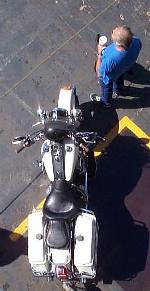 As we set sail from Anacortes, Washington, a passenger enjoys a cup of coffee next to Bob, the Harley, on board the M.V. Yakima. There are 172 San Juan islands, but I will visit only three. Many people mill about the viewing decks and in the cabins, and I meet someone on the upper deck who is going to a wedding on Lopez. Below deck, some people sit in their cars - must be residents, who have taken this ride so many times, they're actually bored with the view.
As we set sail from Anacortes, Washington, a passenger enjoys a cup of coffee next to Bob, the Harley, on board the M.V. Yakima. There are 172 San Juan islands, but I will visit only three. Many people mill about the viewing decks and in the cabins, and I meet someone on the upper deck who is going to a wedding on Lopez. Below deck, some people sit in their cars - must be residents, who have taken this ride so many times, they're actually bored with the view.
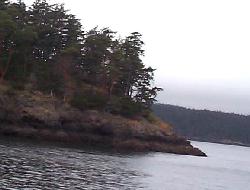 We escape the crowded bustle of the mainland, and though we are within commuting distance of the largest city in Washington state, and close enough to Microsoft to launch a tangerine iMac through their windows, we are in complete wilderness. Islands sprout from the water like large, resting whales. Some have the delicacy to slope gently toward the sea, their trees looking like a soft, green carpet. Many islands are simply large, round rocks, like baseballs in a puddle, with bare edges cutting into the sea. The trees crown the tops of these islands, as if they were afraid of the water.
We escape the crowded bustle of the mainland, and though we are within commuting distance of the largest city in Washington state, and close enough to Microsoft to launch a tangerine iMac through their windows, we are in complete wilderness. Islands sprout from the water like large, resting whales. Some have the delicacy to slope gently toward the sea, their trees looking like a soft, green carpet. Many islands are simply large, round rocks, like baseballs in a puddle, with bare edges cutting into the sea. The trees crown the tops of these islands, as if they were afraid of the water.

 After a 45-minute ride, we arrive at Shaw Island, home to only a few hundred people (including Bill Gates' father, sometimes.) We are greeted at the Shaw Island dock by a sister of the Franciscan convent there. The sister doesn't bless us weary travelers - not formally, at least - and she doesn't even lead us in song. These fine ladies take turns, each time a ferry boat arrives, at donning a reflective vest and 2-way radio, walking out on the dock, and lowering the hydraulic-operated, steel gangplank onto the deck of the ship.
After a 45-minute ride, we arrive at Shaw Island, home to only a few hundred people (including Bill Gates' father, sometimes.) We are greeted at the Shaw Island dock by a sister of the Franciscan convent there. The sister doesn't bless us weary travelers - not formally, at least - and she doesn't even lead us in song. These fine ladies take turns, each time a ferry boat arrives, at donning a reflective vest and 2-way radio, walking out on the dock, and lowering the hydraulic-operated, steel gangplank onto the deck of the ship.
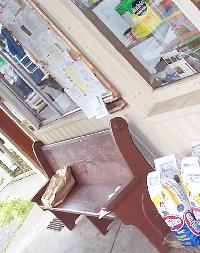 The Franciscans acquired a contract from the state 11 years ago to operate this dock, and they also run the "Little Portion Store" next door. Not sure what security system they have, but the nuns don't haul those bags of charcoal in every night - people just come by and say; "I took some charcoal last week, how much do I owe you?" The bread man dashes off the ferry with a bin of loaves and puts it by the door - they'll get it in the morning.
The Franciscans acquired a contract from the state 11 years ago to operate this dock, and they also run the "Little Portion Store" next door. Not sure what security system they have, but the nuns don't haul those bags of charcoal in every night - people just come by and say; "I took some charcoal last week, how much do I owe you?" The bread man dashes off the ferry with a bin of loaves and puts it by the door - they'll get it in the morning.
 The bulletin board on the front of the store is classic small-town. A luncheon will be held next Wednesday, a small concert next month. A hat, and eyeglasses were lost (could they be Bill's?) then found, then tacked to the board. Obituaries show up here; one is just a handwritten note: "Harold Whittaker died last week."
The bulletin board on the front of the store is classic small-town. A luncheon will be held next Wednesday, a small concert next month. A hat, and eyeglasses were lost (could they be Bill's?) then found, then tacked to the board. Obituaries show up here; one is just a handwritten note: "Harold Whittaker died last week."
 Shaw is a beautiful island. Mostly forested, it has a small school, museum / library, firehouse, campground, airstrip and two convents (the other convent, named "Our Lady of the Ark" manages a dairy farm). The island depends very little on tourism, but many of the residents are retired, and the others live off them. Just joking, but I wasn't nosy enough to ask what everybody did for a living.
Shaw is a beautiful island. Mostly forested, it has a small school, museum / library, firehouse, campground, airstrip and two convents (the other convent, named "Our Lady of the Ark" manages a dairy farm). The island depends very little on tourism, but many of the residents are retired, and the others live off them. Just joking, but I wasn't nosy enough to ask what everybody did for a living.
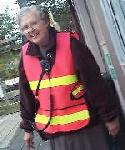 Speaking of nosy, I pushed my luck with the nuns. Unable to contact them in advance, I had taken the trip to Shaw in hopes of telling their story. But, their story had been told enough, they thought, and they politely brushed me off. This order does get its share of attention; "lots of people take photographs of us," said the sister at the dock.
Speaking of nosy, I pushed my luck with the nuns. Unable to contact them in advance, I had taken the trip to Shaw in hopes of telling their story. But, their story had been told enough, they thought, and they politely brushed me off. This order does get its share of attention; "lots of people take photographs of us," said the sister at the dock.
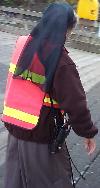 I guess writers get a kick out of showing this group of gentle ladies in contrast to their roles as dock workers, and boy, am I guilty. I wanted to ask them all the questions which they had been asked dozens of times before, and take the same photographs, but they insisted that I not do that, and around here, the sister's word is law. But they did let me photograph them, like all the other tourists do, and if you want to see their tattoos (all dock workers have tattoos, don't they?) or if you want to know their names, or what names they call the captain when he hits their dock with his boat, you'll just have to ask them yourself.
I guess writers get a kick out of showing this group of gentle ladies in contrast to their roles as dock workers, and boy, am I guilty. I wanted to ask them all the questions which they had been asked dozens of times before, and take the same photographs, but they insisted that I not do that, and around here, the sister's word is law. But they did let me photograph them, like all the other tourists do, and if you want to see their tattoos (all dock workers have tattoos, don't they?) or if you want to know their names, or what names they call the captain when he hits their dock with his boat, you'll just have to ask them yourself.
 I spend the night on Shaw, and head out in the morning. On board the M.V. Nisqually, we take a quick jaunt to Lopez Island. Passengers have set up camp in the cabin. Some bring a picnic lunch, as a way of saving money and giving the kids something to do, beside pester the crew and toss large objects overboard. There are many tourists here, and some people are even sailing to or from British Columbia, Canada. Some people play cards or read books, and many just talk. On smaller ferries, which bring workers and residents across rivers, there is a greater sense of utility and loneliness. But on these larger ships, you see many couples and families and social groups, and it is a much brighter atmosphere.
I spend the night on Shaw, and head out in the morning. On board the M.V. Nisqually, we take a quick jaunt to Lopez Island. Passengers have set up camp in the cabin. Some bring a picnic lunch, as a way of saving money and giving the kids something to do, beside pester the crew and toss large objects overboard. There are many tourists here, and some people are even sailing to or from British Columbia, Canada. Some people play cards or read books, and many just talk. On smaller ferries, which bring workers and residents across rivers, there is a greater sense of utility and loneliness. But on these larger ships, you see many couples and families and social groups, and it is a much brighter atmosphere.

I was stuck in rain while on Lopez, and I didn't get any photographs. On Orcas Island, there are several llama farms, and I guess they like the cold, damp days here.
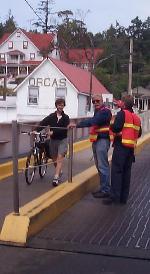 Orcas is the largest of the San Juan Islands, and has a beautiful, little town. A popular outing for Washingtonians is a bike ride around the islands. You can rent a bike for about $20 a day, and you should be able to pedal at least 3 islands. If you're already off the mainland (i.e., vacationing for a few days) the ride around the islands is free. This is a great way to travel, as you get to ride, and then take a break, then ride and take a break... There are some serious cyclists here, and they are not allowed to ride their bikes on the ship, or they would probably be climbing the steps up to the bridge.
Orcas is the largest of the San Juan Islands, and has a beautiful, little town. A popular outing for Washingtonians is a bike ride around the islands. You can rent a bike for about $20 a day, and you should be able to pedal at least 3 islands. If you're already off the mainland (i.e., vacationing for a few days) the ride around the islands is free. This is a great way to travel, as you get to ride, and then take a break, then ride and take a break... There are some serious cyclists here, and they are not allowed to ride their bikes on the ship, or they would probably be climbing the steps up to the bridge.

 Riding back to Anacortes on the M.V. Yakima, I hear some beautiful harp music coming from the forward cabin, and I find David Michael, an enterprising musician, entertaining the passengers. I don't get a chance to talk with him very much before we dock, but he rides this ship during the summer to relax, practice and sell his CDs. He has recorded over half a dozen albums, and his latest theme seems to be Celtic harp. Hearing him play is a nice way to end the day, and soon we dock at Anacortes, the mainland, and we're back in the real world.
Riding back to Anacortes on the M.V. Yakima, I hear some beautiful harp music coming from the forward cabin, and I find David Michael, an enterprising musician, entertaining the passengers. I don't get a chance to talk with him very much before we dock, but he rides this ship during the summer to relax, practice and sell his CDs. He has recorded over half a dozen albums, and his latest theme seems to be Celtic harp. Hearing him play is a nice way to end the day, and soon we dock at Anacortes, the mainland, and we're back in the real world.
|
|